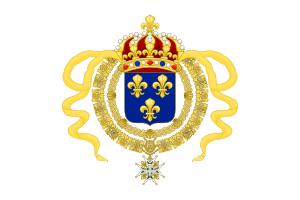History of Cleveland County, Oklahoma facts for kids
The history of Cleveland County, Oklahoma tells the story of this area before it became a county in the U.S. state of Oklahoma in 1907. For a long time, this land was on the edge of where the Plains Indians lived. Later, both France and Spain explored and claimed the area. Eventually, it became part of the United States through the Louisiana Purchase. It then became U.S. territory and tribal land, finally joining the state of Oklahoma.
Contents
Early History (Before 1682)
Before Europeans arrived, the land that is now Cleveland County was on the eastern edge of the Plains Indians' territory. The Cross Timbers region, which runs through eastern Cleveland County, formed a natural border for the Great Plains. Plains Indians usually did not go into the Cross Timbers.
Tribes that hunted in this area included the Comanche, Kiowa, Tonkawa, and Wichita. In 1545, Andres do Campo and two other Spaniards might have been the first known Europeans here. They had been held captive by the Kaw Indians in Kansas. After escaping, they likely crossed Cleveland County while heading back to New Spain.
European Claims (1682-1803)
In 1682, Robert de La Salle claimed the Mississippi River and all the land it drained for France. This huge area included what is now Cleveland County. French traders, called voyageurs, traveled the Arkansas River, Canadian River, and Red Rivers in their canoes. They traded with Indians from their bases in Natchitoches, Louisiana and Arkansas Post.
In 1740, two French Canadians, Pierre Antoine and Paul Mallet, explored near future Cleveland County. They were returning from Santa Fe and followed the Canadian River east. They hoped to find a trade route connecting Santa Fe with Missouri and New Orleans.
After France lost the French and Indian War, they gave the land west of the Mississippi River to Spain. This happened with the Treaty of Fontainebleau in 1762. For 80 years, the Cleveland County area was under French rule.
The Spanish explored parts of Oklahoma when it was part of New Spain. However, they never ventured into what is now Cleveland County. In 1800, France got the territory back from Spain in the Third Treaty of San Ildefonso. Spain still managed the region for a while. For 38 years, the Cleveland County area was under Spanish rule.
In 1803, France sold the huge Louisiana Territory to the United States for $15 million. This sale is known as the Louisiana Purchase. After just three years of French rule, what is now Cleveland County became part of the United States.
Becoming U.S. Territory (1803-1907)
On October 20, 1803, the area of Cleveland County officially joined the United States as part of the Louisiana Purchase. It became part of the District of Louisiana and was managed by the governor of Indiana Territory. The main city was Saint Louis, Missouri.
When Louisiana became a state in 1812, the District of Louisiana was renamed Missouri Territory. This avoided confusion with the new state. On March 2, 1819, the Cleveland County area became part of Arkansas Territory, managed from Fort Smith, Arkansas. This area was removed from Arkansas Territory in 1824.
In August 1820, Major Stephen H. Long traveled through future Cleveland County. He was returning from an exploration trip to Pikes Peak, known as the Long-Bell Expedition. Long wrote in his journal about huge prairie dog towns and many elk, deer, and bear. Botanist Edwin James joined Long and wrote about the trip in his book From Pittsburgh To The Rocky Mountains.
In autumn 1832, Captain Jesse Bean led U.S. Rangers through present-day Cleveland County. They aimed to make peace between the Plains Indians and the recently moved Five Civilized Tribes. They camped on Bishop Creek in present-day Norman. There, they were almost run over by a herd of stampeding buffalo. Author Washington Irving joined this trip and wrote about it in his book A Tour On The Prairies.
On March 24, 1832, the area of Cleveland County was given to the Creek Tribe through the Treaty of Cusseta. The Creeks were one of the Five Civilized Tribes and had been moved from Alabama. This area became part of the Creek Nation, with its capital at Okmulgee.
In summer 1834, the First Dragoon Expedition passed through present-day Cleveland County. They had just met with Plains Indians in western Indian Territory. They successfully got a 9-year-old boy, kidnapped from Texas, released. The expedition crossed the Canadian River between present-day Norman and Lexington. Sergeant Hugh Evans wrote that there were large herds of buffalo on both sides of the river. Artist George Catlin joined this expedition.
Indian Territory (1834-1890)
On June 30, 1834, Indian Territory, which included present-day Cleveland County, was officially created by the Congress.
In May 1835, soldiers from Fort Gibson set up an outpost called Camp Holmes. It was named after Lieutenant Theophilus H. Holmes. This outpost was on Chouteau Creek, near where Slaughterville is today. It was used for talks between the U.S. Government and Indian tribes from the southern plains. A treaty was signed with the Comanche and Wichita tribes on August 24 or 25, 1835. Camp Holmes was also known as "Camp Mason" or "Mason's Fort" after Major Richard B. Mason, who built the post.
After the Treaty of Camp Holmes was signed, the soldiers left Camp Holmes. A trader named Auguste P. Chouteau then set up a trading post there. He traded with the plains tribes. This site was known as Chouteau's Trading Post or "Chouteau's Fort." Chouteau died in 1838, and the trading post was abandoned.
In 1839, Dr. Josiah Gregg traveled from Fort Smith, Arkansas, to Santa Fe. He had $25,000 worth of goods in wagons, 30 men, and two cannons. He hoped to trade with the Mexicans. Gregg followed the Canadian River west and camped at Chouteau's abandoned post. There, 40 soldiers from Fort Gibson met him. They were ordered to escort Gregg to the 100th meridian, which was then the U.S. border. Gregg wrote about his trading days in his book Commerce Of The Prairies. He returned to Fort Smith in 1840 using the same route.
In summer 1843, Captain Nathan Boone, son of Daniel Boone, entered what is now Cleveland County. He was on a mission to explore the Santa Fe Trail and central Indian Territory. Boone and his soldiers camped on Bell Creek in the Noble area. The next day, Boone stopped at Chouteau's old abandoned post to rest his men and horses before heading east to Fort Gibson.
In summer 1845, an expedition led by Lieutenant James W. Abert traveled down the Canadian River to present-day Cleveland County. Abert camped in the areas of Norman and Noble. He also stopped at Chouteau's old trading post. Abert wrote about the post: "A tall gate-post was leaning sadly over the ruins... We saw pieces of wagons, showing the place had been empty for a long time. " Chouteau's Post had been abandoned for seven years by then. Abert and his men continued to Fort Gibson.
The California Gold Rush led many people to travel west to find gold. Captain Randolph B. Marcy was told to lead a wagon train west and create a trail to Santa Fe, New Mexico. Marcy left Fort Smith, Arkansas in May 1849, following the Canadian River. He mostly stayed on the south side of the river. However, a northern branch of the California Road stayed on the north side from Eufaula to Chouteau's old trading post. It then crossed the Canadian there, rejoining the southern branch. Some Kichai Indians lived near the old post at this time. Marcy wrote a guide book for travelers called The Prairie Traveler.
Jesse Chisholm, famous for the Chisholm Trail, set up a trading post at Chouteau's old post in 1854. He ran it off and on until his death in 1868. Chisholm traded with the Plains Indians and those traveling west on the California Road.
Seminole Nation (1856-1866)
On August 7, 1856, the area that is now Cleveland County was given to the Seminole Tribe. The Seminoles were one of the Five Civilized Tribes, and their capital was at Wewoka. The Seminoles had been moved from Florida.
In November 1858, Edward F. Beale was surveying a wagon road from Fort Smith, Arkansas, to the Colorado River. He passed by Chisholm's Post. Beale wrote, "I rode... and discovered... the remains of old Choteau's trading post; looking among the ruins, I found a human skull..." It seems Chisholm was not doing business there at this time. Beale called this area Kichai Indian country, so the tribe likely still lived nearby.
Civil War (1861-1865)
On August 1, 1861, the Seminole Nation joined the Confederacy. However, one group of Seminoles sided with the Union. This group, led by Chief Chupco, fled to Kansas. Chief Chupco later became a First Sergeant in the Indian Home Guard.
The Seminoles loyal to the Confederates were led by Chief John Jumper. They formed the 1st Battalion Seminole Mounted Volunteers and the 1st Regiment Seminole Mounted Volunteers.
After the Civil War, with the Reconstruction Treaties of 1866, the Seminoles were forced to sell their lands in present-day Cleveland County. This was because they had sided with the Confederacy. This created an open area known as the Unassigned Lands.
Late 1800s
In the 1870s, many Texas cattlemen wanted to move their cattle north to railways in Kansas. From there, they could ship their beef to markets in Chicago. The Arbuckle Trail was an eastern branch of the Chisholm Trail. It crossed the Red River at Thacker Ferry. It then ran north to Fort Arbuckle, then to what is now Norman, and finally northwest to Kingfisher, where it rejoined the Chisholm Trail.
A Cherokee man named Dave Blue built a trading post on Dave Blue Creek in present-day Norman. He hired Cherokee and Creek Indians to hunt buffalo. Then, he shipped the hides to Atoka to sell them.
In 1871, the U.S. Land Office hired Theodore H. Barrett to survey a north/south route for a railroad. A year later, in November 1872, a survey crew led by Abner E. Norman camped overnight at a spring on Bishop Creek. One of the men carved "Norman's Camp" into a large elm tree.
In 1885, the Kansas Southern Railway got permission to build a railroad from Arkansas City to Purcell. They used the route Barrett had surveyed. Railroad officials chose a 13.5-acre site about 1.5 miles north of "Norman's Camp" for a station. The line reached Norman Station on April 15, 1885, and was finished at Purcell on April 26. In Purcell, it connected with another line from Galveston. The Kansas Southern Railway was sold to the Atchison, Topeka and Santa Fe Railway (AT&SF) in 1899. In 1996, the AT&SF merged with the Burlington Northern Railroad to form the Burlington Northern Santa Fe Railway (BNSF). The first passenger train arrived at Norman Station on June 13, 1887.
On December 19, 1890, the territorial government decided to place the University of Oklahoma in Norman, Oklahoma. The town had to donate 40 acres and raise $10,000. In 1892, the first students enrolled at the school.
Oklahoma (1907-Present)
When Oklahoma became a state in 1907, Cleveland County had 18,460 people. The county's early economy was based on farming. A year after statehood, in 1907, there were 371,640 acres of farmland.
By the 1920s, the University of Oklahoma campus had grown to 267 acres. The population of Norman, the county's largest city, continued to grow, reaching 9,603 by 1930.
In 1939, a new county courthouse was built. It replaced an older building from 1906.





